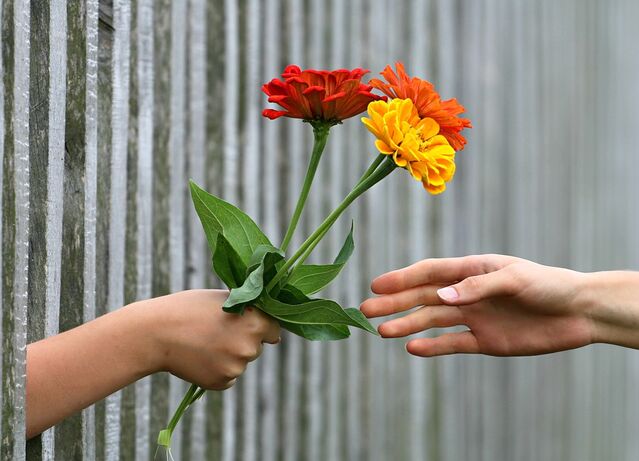Relationships
Frustration Attraction—How Separation Heightens Passion
The essential paradox of love and desire is that connection requires separation.
Posted October 26, 2020 Reviewed by Lybi Ma

There’s a principle in Japanese garden design called miegakure, or hide-and-reveal, in which only a portion of any object is exposed, never the whole of it. A teahouse is partially hidden behind an arbor, a creek comes in and out of view, the main body of rocks are set deep in the ground, gardens are partly concealed by lanterns and fences.
The idea is that revealing only parts of the whole helps keep the viewer’s interest peaked, teasing the imagination and giving it a little mystery to figure out.
This is the same principle that explains why partial nudity is often more alluring than full nudity—the transparent blouse that suggests the contours of her breasts, the bath towel slung low over his hipbones. What’s concealed incites the imagination and stokes desire because something is withheld from us. Something we want.
If we want passion in our relationships, it behooves us to stay hungry. To build in a little anticipation from time to time, the occasional partings that make the heart grow fonder, a little healthy distance from one another, and the understanding that the essential paradox of love—and the critical ingredient in erotic relationships—is that connection requires separateness, and to not merely tolerate but celebrate that space-between. And if cultivating separateness feels too hardboiled, think of it as cultivating selfhood, which is the best thing you can do for the health of a relationship anyway.
Although one of the most common insights from our spiritual traditions is the boundary-dissolving revelation that “it’s all connected,” a certain amount of separateness is still an operational necessity. You may romanticize togetherness—the two shall be as one, you complete me, I’m no one without you, one flesh-one heart—but fusing into an indistinguishable gob of attachment is not true intimacy; it’s cannibalism. Thus the lover’s refrain, “I could just eat you.”
This idea of the boundaryless union may appeal to the romantic in us, as well as to our spiritual visions of oneness and our prenatal memories of blissful unity, but in the rubber-meets-the-road world of grownup relationships, it’s called enmeshment.
But how comfortable you feel with the concept of the gap may depend on how you feel about the experience of separation generally, which at a primal level none of us is entirely comfortable with. Buried deep in the mud at the bottom of human consciousness is the memory of how to survive, and parting with the herd is not the way to do it.
It also depends on how your parents met the challenge of helping you separate from them. If your initial attempts at autonomy were met with resistance or punished rather than rewarded, you might naturally have concluded that independence is dangerous and separation threatening to your connection with others.
Granted, some relationships may be characterized by too much gap rather than too little. Partners may feel like the proverbial ships passing in the night or spend the majority of their time together but be emotionally divorced. This raises a question every couple must answer for themselves: How much space is enough? When does independence enhance passion, and when does it snuff it out?
It can, of course, be difficult to even broach the subject of separateness with a partner—especially one with whom you’re power-struggling over how much time to spend together—without it coming across as “I need some space,” which most people hear as rejection. But passion is served by a little separation, as long as you’re not enmeshed in distancer/pursuer dynamics, or the parting that makes the heart grow fonder doesn't devolve into “out of sight out of mind,” or separation doesn’t turn fatally inward. That is, if your retreats are counterpoised with advances, and you return from them bearing the gifts of your solitude, then your leave-takings aren’t likely to backfire or turn into habits of evasion.
Desire depends on an age-old dynamic in the erotic arts: elusiveness. The fan that veils the face, the sideways glance, the tease, the blindfold, the game of hard-to-get. As they say, when there’s nothing left to hide, there’s nothing left to seek. “The most alluring,” says Alain de Botton in On Love, “aren’t the ones who let us kiss them too soon, or make us wait too long, but those who know how to carefully administer varied doses of hope and despair.”
Delayed gratification intensifies desire, and this is not just an emotional fact but a biological one. It stimulates the activity of dopamine, one of the brain’s natural stimulants and kin to adrenaline. “Our ability to tolerate separateness, and the fundamental insecurity it engenders,” says Esther Perel in Mating in Captivity: Unlocking Erotic Intelligence, “is a precondition for maintaining interest and desire in a relationship.”
How do you cultivate fruitful frustration in relationships and keep yourself effortful on behalf of love?
Anyone who’s been in a relationship for more than 10 minutes knows that you don’t have to work particularly hard to find frustration there, though using it for the sake of growth and intimacy is another matter. For starters, you might practice deliberately frustrating yourself—challenging your own assumptions and complacencies, confronting the things you take for granted, questioning your belief that there’s nothing new under the sun, and nothing left to learn about your partner.
Or try a silent treatment. Take 24 hours of silence together, temporarily diverting the stream of chatter between you and providing a bit of emotional breathing room. Don’t communicate with words or even written messages, except in emergencies.
Perel suggests creating new email addresses reserved exclusively for erotic exchanges and cyber seductions—with no discussion of the “issues” in your relationship or any of the mundane matters of life. Only teasings and temptations, enticements, and innuendoes.
And here’s a charming and disarming exercise brought to you by Gina Ogden, author of The Return of Desire: Make mad passionate love to your partner for at least a half-hour, but never go above the ankles.
One form of frustration that Perel considers “the seed of wanting” is uncertainty, which can have a stimulating effect in the right doses. Try a weekly date-night during which you swap roles as the initiator of novelty, arranging something you've never done before, somewhere you’ve never been, even including some unexpected guest—and don't tell your partner until the moment-of.
If we were not just smart but wise, we’d more than merely “mind the gap,” as they say in the London tubes. We’d “heart the gap.” We’d teach ourselves to love the gap, not just tolerate it. To love and appreciate the time apart.
Love the thoughts your partner has that aren't about you and the dreams they have that are independent of yours. Love the others who love them and in whose hearts they have a place that doesn’t include you. Love the privacy they cherish, the parts you don’t understand and may never understand.
As for how you learn to “heart the gap,” to love what frightens you, the most expedient approach may be what’s called graduated exposure, often used to overcome phobias and anxiety disorders. You combine gradual and increasing exposure to the feared thing with relaxation exercises and self-soothing, and eventually, you find yourself able to sit in the same room with snakes or spiders or scenarios of the gap and not hyperventilate.
Life and literature are rife with stories about the connection between separation and desire, what some people call frustration attraction. “There are three characters in any story of eros,” says poet Anne Carson. “Lover, beloved, and that which comes between them.” It’s what keeps us turning the pages.
Some of the world’s classic love stories—Tarzan and Jane, Romeo and Juliet, Lancelot and Guinevere, Tristan and Isolde, Scarlett and Rhett—are built on the idea that what powers love is hurdles. And the strength of love is commensurate with how mightily our heroes and heroines struggle against the impediments fate throws in their path.
It may even be fair to say that what mostly comes between lovers and beloveds is one very particular impediment: clinging. Not desire, which is just life-force, but the clinging to our objects of desire, which constricts life-force. In the Afghani tongue, the verb “to cling” is synonymous with the verb “to die.”
But if we're willing to become students of this space-between, then desire can become enlightening instead of just frustrating, and life can become full of teachable moments. Besides, desire and passion don’t ultimately want to be quenched and go out, to settle for the mere possession or mere contentment. They want to be lit and re-lit. They want yearning, not satisfaction. They want to occupy the space between our reach and our grasp.
References
For more about Passion, visit www.gregglevoy.com




